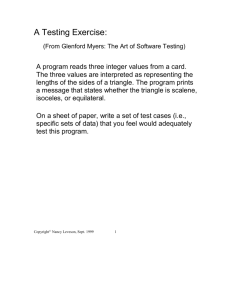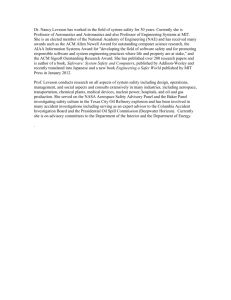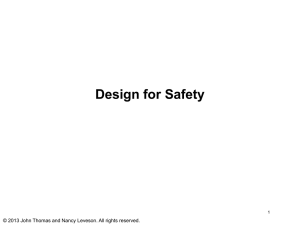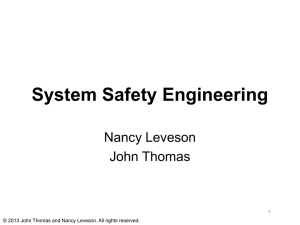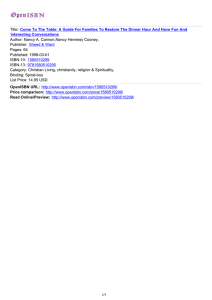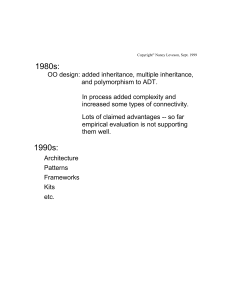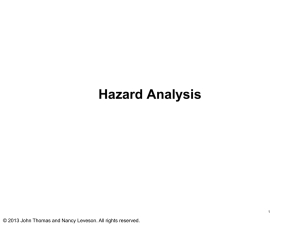Designing to Reduce Human Error
advertisement
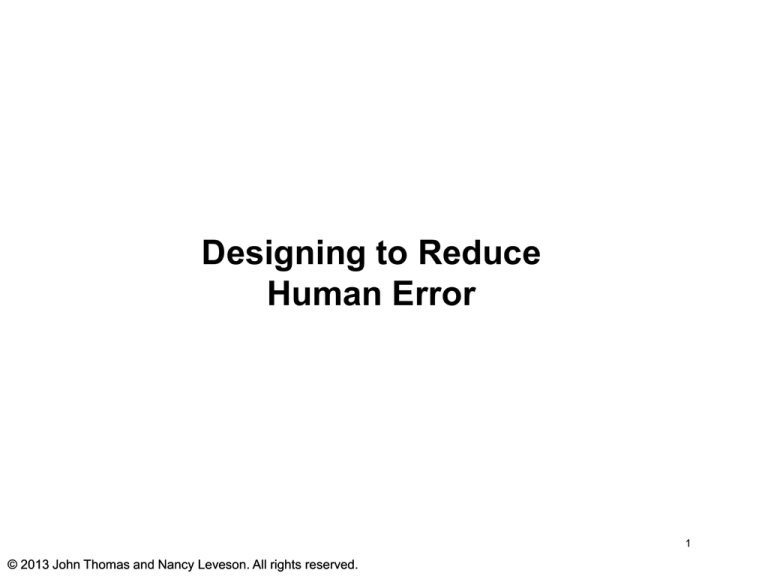
Designing to Reduce Human Error 1 © 2013 John Thomas and Nancy Leveson. All rights reserved. Advantages of Humans • Human operators are adaptable and flexible – Able to adapt both goals and means to achieve them – Able to use problem solving and creativity to cope with unusual and unforeseen situations – Can exercise judgment • Humans are unsurpassed in – Recognizing patterns – Making associative leaps – Operating in ill-structured, ambiguous situations • Human error is the inevitable side effect of this flexibility and adaptability 2 © 2013 John Thomas and Nancy Leveson. All rights reserved. Role of Humans in Automated Systems • The Human as Monitor – Task may be impossible – Dependent on information provided – Difficult (impossible?) to monitor for infrequent events – State of information more indirect – Failures may be silent or masked – Little active behavior can lead to lower alertness and vigilance, complacency, and over-reliance 3 © 2013 John Thomas and Nancy Leveson. All rights reserved. Role of Humans in Automated Systems (2) • The Human as Backup – May lead to lowered proficiency and increased reluctance to intervene – Limited ability to practice to handle “breakdown” scenarios – Fault intolerance may lead to even larger errors – May make crisis handling more difficult 4 © 2013 John Thomas and Nancy Leveson. All rights reserved. Role of Humans in Automated Systems (3) • The Human as Partner – May be left with miscellaneous tasks – Tasks may be more complex and new tasks added – By taking away easy parts, may make difficult parts harder – Problems in communication between humans and automation 5 © 2013 John Thomas and Nancy Leveson. All rights reserved. Consequences of Computers • High tech automation changing cognitive demands on operators – Supervising rather than directly monitoring – More cognitively complex decision-making – Complicated, mode-rich systems – Increased need for cooperation and communication • Human-factors experts complaining about technologycentered automation – Designers focus on technical issues, not on supporting operator tasks – Leads to “clumsy” automation 6 © 2013 John Thomas and Nancy Leveson. All rights reserved. Mixing Humans and Computers • Automated systems on aircraft have eliminated some types of human error and created new ones – Errors of commission vs. errors of omission • Human skill levels and required knowledge may go up • Correct partnership and allocation of tasks is difficult Who has the final authority? • Authority limits – Prevent actions that would lead to hazardous states but – May prohibit maneuvers needed in extreme situations. 7 © 2013 John Thomas and Nancy Leveson. All rights reserved. Incidents related to Operator Authority Limits • Warsaw • LAX incident: – During one A320 approach, pilots disconnected the autopilot while leaving the flight director engaged. – Under these conditions, the automation provides automatic speed protection by preventing aircraft from exceeding upper and lower airspeed limits. – At some point during approach, after flaps 20 had been selected, the aircraft exceeded the airspeed limit for that configuration by 2 kts. As a result, the automation intervened by pitching the aircraft up to reduce airspeed back to 195 kts. – The pilots, who were unaware that automatic speed protection was active, observed the uncommanded automation behavior. Concerned about the unexpected reduction in airspeed at this critical phase of flight, they rapidly increased thrust to counterbalance the automation. As a consequence of this sudden burst of power, the aircraft pitched up to about 50 degrees, entered a sharp left bank, and went into a dive. – The pilots eventually disengaged the autothrust system and its 8 associated protection function and regained control of the aircraft. © 2013 John Thomas and Nancy Leveson. All rights reserved. Typical Problems with IT • Getting lost in display architecture – Difficult to find right page or data set • Not coordinating computer entries among multiple people entering things • Workload – Often increase demand at time when already a lot to do – Heads down work in aircraft • Data overload, “keyhole problem” – May have to sort through large amounts of data to find pieces that reveal true nature of situation – Then need to integrate information • Digital displays may require extra mental processing – Hard to notice changes (events, trends) with digital values clicking up and down © 2013 John Thomas and Nancy Leveson. All rights reserved. 9 Cognitive Consequences of Computers • Increase memory demands • New skill and knowledge demands • Can complicate situation assessment • Can undermine people’s attention management • Can disrupt efficient and robust scanning patterns • Can lead to limited visibility or changes and events, alarm and indication clutter, extra interface management tasks • By increasing system reliability, can provide little opportunity to practice and maintain skills for managing system anomalies • Force people into using tricks necessary to get task done that may not work in uncommon situations. 10 © 2013 John Thomas and Nancy Leveson. All rights reserved. Designing for Human Control • Human error is not random. It is systematically connected to features of people’s tools, tasks, and operating environment. • Two ways to assist in human factors design: – Use hazard analysis (STPA) to provide information for human-machine interaction and interface design. – Apply general design principles based on what is known about human factors 11 © 2013 John Thomas and Nancy Leveson. All rights reserved. Updating Process Models 12 © 2013 John Thomas and Nancy Leveson. All rights reserved. Human Factors in Accidents • Slips vs. mistakes • Errors of omission vs. errors of commission (Sarter and Woods) – Related to changing role of humans in systems (supervisors of automated controllers) – Cognitive demands may not be reduced but simply change in their basic nature – Reduce some types of human errors but introduce new ones 13 © 2013 John Thomas and Nancy Leveson. All rights reserved. Physical vs. Human Controllers Physical controllers have fixed control algorithms 14 © 2013 John Thomas and Nancy Leveson. All rights reserved. Human controllers have dynamic control algorithms (John Thomas) 15 © 2013 John Thomas and Nancy Leveson. All rights reserved. Implications of Differences • Most of STPA still holds. • Analyze control algorithm as defined in procedures or control requirements • New task of understanding and preventing unsafe changes in control algorithm. – Starts from basic human factors principles – Design process to lessen impact of common factors – Provide training on hazards and hazardous behavior, reasons for design, etc. – Audit practices to detect unsafe changes 16 © 2013 John Thomas and Nancy Leveson. All rights reserved. Providing Control Options 17 © 2013 John Thomas and Nancy Leveson. All rights reserved. Providing Control Options • Avoid designs that require or encourage management by exception. • Operators must have adequate flexibility to cope with undesired behavior and not be constrained by inadequate control options (Rasmussen) 18 © 2013 John Thomas and Nancy Leveson. All rights reserved. Providing Control Options • Design for incremental control: – Can observe controlled process and get feedback about previous steps. – Can modify or abort control actions before significant damage done – Must provide operator with compensating actions for incremental actions that have undesired effects. • Provide multiple ways to change from an unsafe to a safe state. • Provide multiple physical devices and logical paths to ensure that a single hardware failure or software error cannot prevent operator from taking action to maintain a safe system state and avoid hazards. 19 © 2013 John Thomas and Nancy Leveson. All rights reserved. Design for Error Tolerance • Many systems limit people’s ability to detect and recover from their errors. • In error tolerant systems: – Errors are observable (within an appropriate time limit) – Errors are reversible before unacceptable consequences • Same true for computer errors: make them observable and reversible • In general, allow controllers to monitor their own performance 20 © 2013 John Thomas and Nancy Leveson. All rights reserved. Design for Error Tolerance (2) • To design for error tolerance: – Help operators monitor themselves and recover from errors – Provide feedback about actions operators took (in case inadvertent, e.g., echoing back operator inputs and requiring confirmation) and effects – Allow for recovery from erroneous actions • Control options (compensating or reversing actions) and • Time for recovery actions to be taken 21 © 2013 John Thomas and Nancy Leveson. All rights reserved. Matching Tasks to Human Characteristics 22 © 2013 John Thomas and Nancy Leveson. All rights reserved. Matching Tasks to Human Characteristics • Tailor systems to human requirements instead of vice versa • Design to withstand normal, expected human behavior • Design to combat lack of alertness • Maintain active engagement in tasks • Allow latitude in how tasks are accomplished. • Avoid designs that require or encourage management by exception. 23 © 2013 John Thomas and Nancy Leveson. All rights reserved. Matching Tasks to Human Characteristics (2) • Distinguish between providing help and taking over. – Do not oversimplify the operator’s task • Maintain manual involvement or ways to update mental models. • Design tasks to be stimulating and varied, to provide good feedback, and to require active involvement of the operators in most operations. • Minimize activities requiring passive or repetitive action. 24 © 2013 John Thomas and Nancy Leveson. All rights reserved. Designing to Reduce Common Human Errors 25 © 2013 John Thomas and Nancy Leveson. All rights reserved. Reducing Human Errors • Make safety-enhancing actions easy, natural, and difficult to omit or do wrong Stopping an unsafe action leaving an unsafe state should require one keystroke • Make dangerous actions difficult or impossible Potentially dangerous commands should require one or more unique actions. • Provide references for making decisions • Integrate critical actions into one task. • Follow human stereotypes and cultural norms 26 © 2013 John Thomas and Nancy Leveson. All rights reserved. Reducing Human Errors (2) • Make sequences dissimilar if need to avoid confusion between them • Make errors physically impossible or obvious • Use physical interlocks (but be careful about this) • Make safety-critical steps incremental. • Distinguish the override of safety-critical vs. non-safety critical errors or hazard indications. • While safety interlocks are being overridden, their status should be displayed. • After an emergency stop, require operator to go through entire restart sequence. 27 © 2013 John Thomas and Nancy Leveson. All rights reserved. Reducing Human Errors (3) • Distinguish processing from failure. Provide real-time indication that • Automated control system is functioning • Information about internal state (such as sensors and actuators), control actions, and assumptions about system state. • Provide facilities for operators to experiment, to update their mental models, and to learn about system. • Design to enhance operator’s ability to make decisions and to intervene when required in emergencies. • Allow operator to maintain manual involvement and to update mental models, maintain skills, and preserve self-confidence. 28 © 2013 John Thomas and Nancy Leveson. All rights reserved. Support Maintaining Accurate Process Models 29 © 2013 John Thomas and Nancy Leveson. All rights reserved. Human may also need model of automation Human Controller Control Algorithm Control Commands Model of Controlled Process Model of automation Has implications for training and for design of automation. Common problems: • inconsistent behavior • unintended side effects © 2013 John Thomas and Nancy Leveson. All rights reserved. Feedback 30 Inconsistent Behavior • Harder for operator to learn how automation works • Important because pilots (and others) report changing scanning behavior Examples: – In go-around below 100 feet, pilots failed to anticipate and realize autothrust system did not arm when they selected TOGA power because it did so under all other circumstances where TOGA power is applied (found in simulator study of A320). – Similar thing happened in Cali accident – Bangalore (A320): A protection function is provided in all automation configurations except the ALTITUDE ACQUISITION mode in which autopilot was operating. 31 © 2013 John Thomas and Nancy Leveson. All rights reserved. Unintended Side Effects An action intended to have one effect has an additional one Example (A320): – Because approach is such a busy time and the automation requires so much heads down work, pilots often program the automation as soon as they are assigned a runway. In an A320 simulator study, discovered that pilots were not aware that entering a runway change AFTER entering the data for the assigned approach results in the deletion of all previously entered altitude and speed constraints even though they may still apply. 32 © 2013 John Thomas and Nancy Leveson. All rights reserved. Modes • Define mutually exclusive sets of automation behavior • Used to determine how to interpret inputs or to define required controller outputs • Four general types: – Controller operating modes (sets of related behaviors in controller, e.g., nominal behavior, shutdown, faulthandling) – Supervisory modes (who or what is controlling the component at any time) – Display modes (affects information provided on display and how user interprets it) – Controlled process modes 33 © 2013 John Thomas and Nancy Leveson. All rights reserved. Mode Confusion • Early automated systems had fairly small number of modes – Provided passive background on which operator would act by entering target data and requesting system operations • Also had only one overall mode setting for each function performed – Indications of currently active mode and of transitions between modes could be decided to one location on display • Consequences of breakdown in mode awareness fairly small – Operators seemed able to detect and recover from erroneous actions relatively quickly 34 © 2013 John Thomas and Nancy Leveson. All rights reserved. Mode Confusion (2) • Flexibility of advanced automation allows designers to develop more complicated, mode-rich systems • Result is numerous mode indications spread over multiple displays, each containing just that portion of mode status data corresponding to a particular system or subsystem • Designs also allow for interactions across modes • Increased capabilities of automation create increased delays between user input and feedback about system behavior 35 © 2013 John Thomas and Nancy Leveson. All rights reserved. Mode Confusion (3) • These changes have led to: – Increased difficulty of error or failure detection and recovery – Challenges to human’s ability to maintain awareness of: • Active modes • Armed modes • Interactions between environmental status and mode behavior • Interactions across modes • Two types of problems – Interface interpretation errors – Indirect mode change errors 36 © 2013 John Thomas and Nancy Leveson. All rights reserved. Interface Interpretation Errors • Software interprets input wrong • Multiple conditions mapped to same output Mulhouse (A-320): – Crew directed automated system to fly in TRACK/FLIGHT PATH mode, which is a combined mode related both to lateral (TRACK) and vertical (flight path angle) navigation. – When they were given radar vectors by the air traffic controller, they may have switched from the TRACK to the HDG SEL mode to be able to enter the heading requested by the controller. – However, pushing the button to change the lateral mode also automatically changes the vertical mode from FLIGHT PATH ANGLE to VERTICAL SPEED, i.e., the mode switch button affects both lateral and vertical navigation. – When the pilots subsequently entered “33” to select the desired flight path angle of 3.3 degrees, the automation interpreted their input as a desired vertical speed of 3300 ft. Pilots were not aware of active “interface mode” and failed to detect the problem. – As a consequence of too steep a descent, the aircraft crashed into a mountain. 37 © 2013 John Thomas and Nancy Leveson. All rights reserved. Interface Interpretation Errors (2) Operating room medical device – The device has two operating modes: warm-up and normal. – It starts in warm-up mode whenever either of the two particular settings are adjusted by the operator (anesthesiologist). – The meaning of alarm messages and the effects of controls are different in these two modes, but neither the current device operating mode nor a change in mode are indicated to the operator. – In addition, four distinct alarm-triggering conditions are mapped onto two alarm messages so that the same message has different meanings depending on the operating mode. – In order to understand what internal condition triggered the message, the operator must infer which malfunction is being indicated by the alarm. Display modes: In some devices user-entered target values are interpreted differently depending on the active display mode. 38 © 2013 John Thomas and Nancy Leveson. All rights reserved. Indirect Mode Changes • Automation changes mode without direct command • Activating one mode can activate different modes depending on system status at time of manipulation Bangalore (A320) – Pilot put plane into OPEN DESCENT mode without realizing it. Resulted in aircraft speed being controlled by pitch rather than thrust, i.e., throttles went to idle. – In that mode, automation ignores any preprogrammed altitude constraints. To maintain pilot-selected speed without power, automation had to use an excessive rate of descent, which led to crash short of the runway. How could this happen? Three different ways to activate OPEN descent mode: 1. Pull altitude knob after select lower altitude 2. Pull speed knob when aircraft in EXPEDITE mode. 3. Select a lower altitude while in ALTITUDE ACQUISITION mode. 39 © 2013 John Thomas and Nancy Leveson. All rights reserved. Indirect Mode Changes (2) – Pilot must not have been aware that aircraft was within 200 feet of previously entered target altitude (which triggers ALTITUDE ACQUISITION mode). – Thus may not have expected selection of lower altitude at that time to result in mode transition. – So may not have closely monitored his mode annunciations. – Discovered what happened at 10 secs before impact — too late to recover with engines at idle. 40 © 2013 John Thomas and Nancy Leveson. All rights reserved. Coordination of Multiple Controller Process Models • Crew resource management • NW188 (John Thomas) 41 © 2013 John Thomas and Nancy Leveson. All rights reserved. Providing Information and Feedback 42 © 2013 John Thomas and Nancy Leveson. All rights reserved. Providing Information and Feedback • Analyze task to determine what information is needed (STPA) • Two types of feedback needed: – Effect of operator’s actions To detect human errors – State of controlled system To update mental models To detect system faults 43 © 2013 John Thomas and Nancy Leveson. All rights reserved. Updating Process Models • Automated control system should provide information about – Whether it is functioning (status indicator to distinguish between processing and failure) – Its internal state (such as state of sensors and actuators), its control actions, and its assumptions about the state of system. • Provide for failure of computer displays (by alternate sources of information) – Instrumentation to deal with malfunction must not be disabled by the malfunction. • Provide way for operators to test their hypotheses. • Support detection of non-events © 2013 John Thomas and Nancy Leveson. All rights reserved. 44 Updating Process Models (2) • If operator must monitor computer decision-making, then computer must make decisions in a manner and rate operator can follow. • Do not overload operator with too much information • When task performance requires or implies need to assess timeliness of information, display should include time and date info associated with data • Provide ways for operator to get additional information designer did not foresee would be needed in a particular situation. • Provide alternative means for operators to check safetycritical information. 45 © 2013 John Thomas and Nancy Leveson. All rights reserved. Updating Process Models (3) • If important information changes in a very short interval before or after the operator issues a command (latency), make sure operator is aware of changes. • Do not permit over-rides of potential safety-critical failures or clearing of status data until all data has been displayed and perhaps not until operator has acknowledged seeing it. • While safety interlocks are being overridden, their status should be displayed. Design should require confirmation that interlocks have been restored before allowing resumption of normal operation. • For robot systems, – Signal bystanders when machine is powered up – Provide warnings when hazardous zone is entered – Do not assume humans will not have to enter robot’s area. 46 © 2013 John Thomas and Nancy Leveson. All rights reserved. Detecting Faults and Failures • Automated control system should provide information about – Whether it is functioning (status indicator to distinguish between processing and failure) – Its internal state (such as state of sensors and actuators), its control actions, and its assumptions about the state of system. • Provide for failure of computer displays (by alternate sources of information) – Instrumentation to deal with malfunction must not be disabled by the malfunction. • Provide feedback if commands are canceled (not executed) because of timeouts or other reasons. • Operators cannot monitor performance if information not independent from thing being monitored. • Inform operators about anomalies, actions taken, and current system state • Fail obviously or make graceful degradation obvious to operator © 2013 John Thomas and Nancy Leveson. All rights reserved. 47 Example Accident Bangalore (A320): – PF had disengaged his flight director during approach and was assuming PNF would do the same. – Result would have been a mode configuration in which airspeed is automatically controlled by the autothrottle (the SPEED mode), which is the recommended procedure for the approach phase. – However, the PNF never turned off his flight director, and the OPEN DESCENT mode became active when a lower altitude was selected. – This indirect mode change led to the hazardous state and eventually the accident. – But a complicating factor was that each pilot only received an indication of the status of his own flight director and not all the information necessary to determine whether the desired mode would be engaged. – The lack of feedback or knowledge of the complete system state contributed to the pilots not detecting the unsafe state in time to 48 correct it. © 2013 John Thomas and Nancy Leveson. All rights reserved. Alarms • Issues – Overload – Incredulity response – Relying on as primary rather than backup (management by exception) 49 © 2013 John Thomas and Nancy Leveson. All rights reserved. Alarms (2) • Guidelines – Keep spurious alarms to a minimum – Provide checks to distinguish correct from faulty instruments – Provide checks on alarm system itself – Distinguish between routine and critical alarms. Form of alarm should indicate degree or urgency. – Indicate which condition is responsible for alarm – Provide temporal information about events and state changes – Require corrective action when necessary 50 © 2013 John Thomas and Nancy Leveson. All rights reserved. Displaying Feedback to Human Controllers • Highlight status of safety-critical components or variables and present complete state in unambiguous manner. • Provide scannable displays that allow operators to monitor and diagnose using pattern recognition. Provide information, if appropriate, in a form in which patterns can be easily recognized. • Make all information needed for a single decision process visible at same time. • Avoid displaying absolute values. Show changes and use analog instead of digital displays when they are more appropriate. Provide references for judgment. 51 © 2013 John Thomas and Nancy Leveson. All rights reserved. Displaying Feedback to Human Controllers • Choose icons that are meaningful to users, not necessarily designers. • Minimize semantic distance between interface displays and mental models (the form of the information needed by the user for processing). • Design the control panel to mimic the physical layout of the plant or system. • Flag rather than remove obsolete information from computer displays. Require operator to clear it explicitly or implicitly (e.g., let it scroll off top of screen). 52 © 2013 John Thomas and Nancy Leveson. All rights reserved. Training and Maintaining Skills • May need to be more extensive and deep – Required skill levels go up (not down) with automation • Teach how the software works • Teach operators to think flexibly when solving problems • Teach about safety features and design rationale, – Hazards and reason behind safety-critical procedures and operational rules – Potential result of removing or overriding controls, changing prescribed procedures, and inattention to safety-critical features and operations. Review past accidents and their causes. 53 © 2013 John Thomas and Nancy Leveson. All rights reserved. Training and Maintaining Skills • Teach for general strategies rather than specific responses to develop skills for dealing with unanticipated events • Provide in-depth understanding of process design • Train operators to test hypotheses in appropriate ways. • Train operators in different combinations of alerts and sequences of events, not just single events • Allow for over-learning emergency procedures and for continued practice. Provide limits and specific actions to take in emergencies. • Provide practice in problem solving. © 2013 John Thomas and Nancy Leveson. All rights reserved. MIT OpenCourseWare http://ocw.mit.edu 16.63J / ESD.03J System Safety Fall 2012 For information about citing these materials or our Terms of Use, visit: http://ocw.mit.edu/terms.

